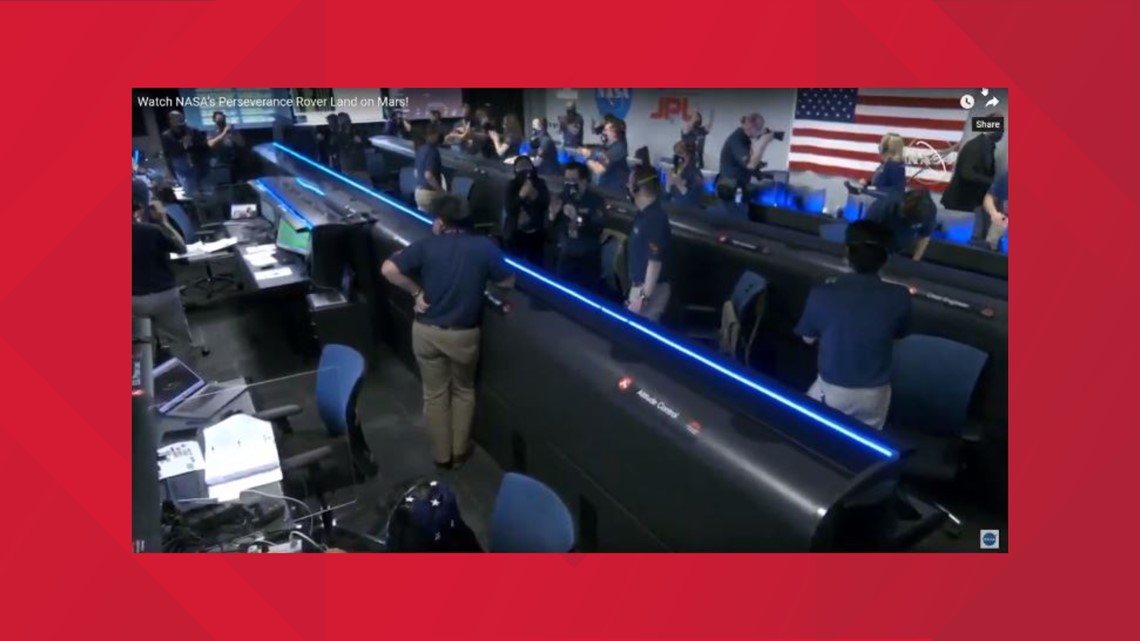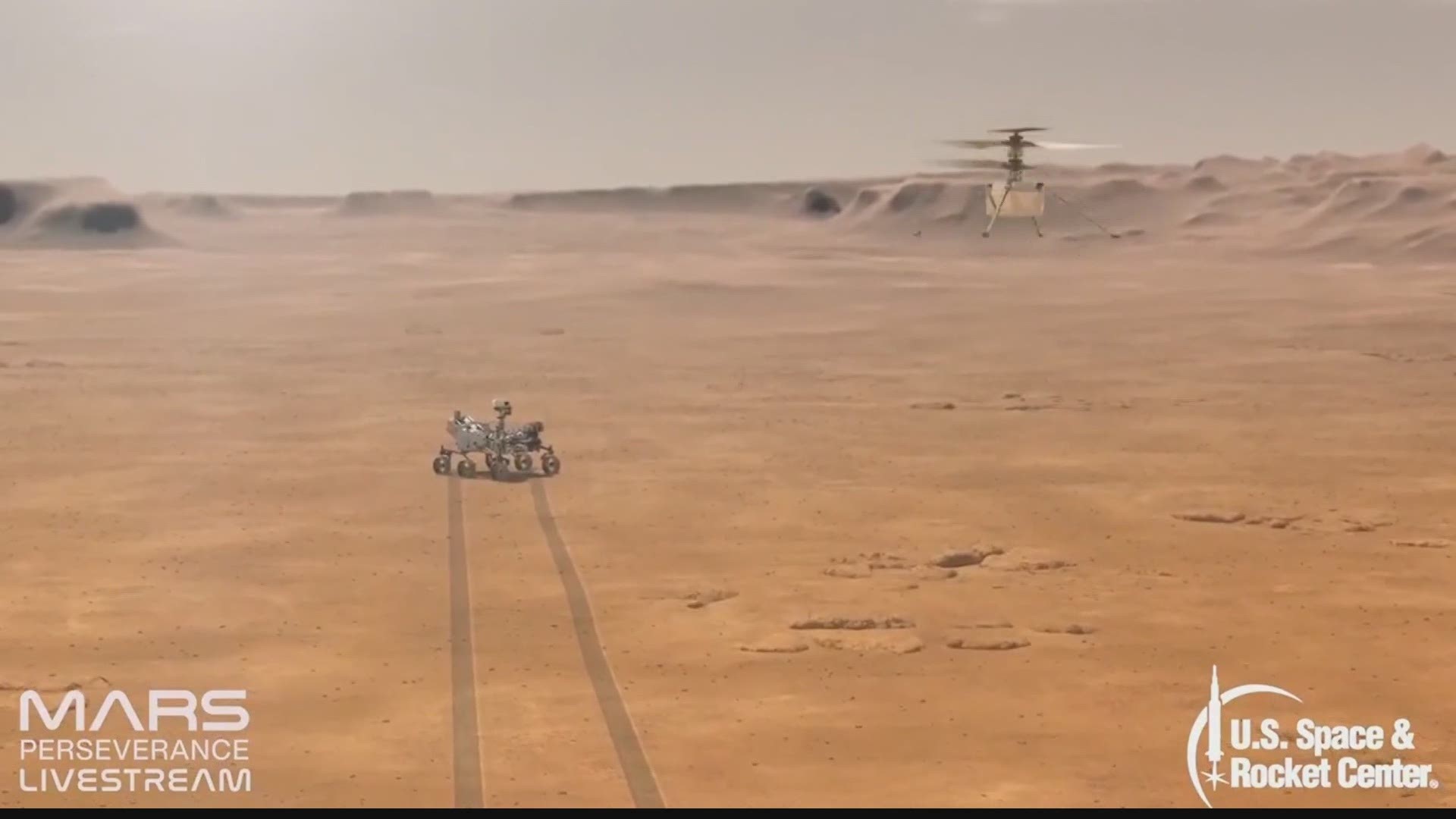HUNTSVILLE, Ala — UPDATE: The Mars landing of Perseverance is complete with the vehicle safely on the planet's surface.
Its mission to explore for signs of past microbial life and prepare samples for future return to Earth will last about one Martian year, or 687 Earth days.
It traveled 293 million miles (471 million kilometers) to get to Mars. For comparison, it's about 2,900 miles from Los Angeles to New York and about 24,900 miles around the Earth's equator. You'd have to circle the earth about 11,767 times to cover the distance from Earth to the Perseverance landing site.
Going 65 miles per hour, it would take 383 hours (16 days) to go around the earth at the equator once. 11,767 trips would take 515 years.
Perseverance made it in 7 months.


Jody Singer, director of NASA’s Marshall Space Flight Center, said:
Today’s landing is a testament to the incredible ingenuity of NASA and I want to congratulate the JPL, Mars 2020 mission and Perseverance teams for this incredible achievement. NASA is embarking on a journey with the Perseverance rover to explore new territory at Jezero Crater in search of clues to Mars's ancient history and geology. What the JPL and NASA teams have done today is nothing short of extraordinary.
Marshall Space Flight Center is proud to be a part of this trailblazing endeavor, as we are developing the Mars Ascent Vehicle. Eventually, we're going to rocket those samples from Perseverance into an orbit around Mars for their return trip to Earth. Missions like Mars 2020 can help us uncover key questions about the potential for past life on Mars and pave the way for human exploration, and I can’t wait to see all the groundbreaking science and discovery from this mission.
From Alabama to Mars:
Marshall Space Flight Center plays a critical role in missions to Mars:
- Marshall planetary scientist Caleb Fassett’s Mars research helped to identify Jezero Crater as a promising landing site.
- Perseverance is the first leg of the Mars Sample Return mission. Marshall is the lead center for the Mars Ascent Vehicle, the rocket that will launch the first-ever samples from the surface of Mars (collected by Perseverance).
- The rover carries two technologies managed by NASA's Technology Demonstration Missions Program, located at Marshall:
- Terrain Relative Navigation will enable the most precise Mars landing ever.
- Mars Oxygen In-Situ Resource Utilization Experiment (MOXIE) will extract CO2 from Martian atmosphere to see if it can make breathable oxygen.
- Ingenuity, the name chosen for the mission’s Mars Helicopter, was suggested by Vaneeza Rupani, a high school student from central Alabama.
- Some of our engineers will be looking at flight data to see how the exhaust from Perseverance’s retrorockets interacts with the Martian surface environment. Their project aims to improve our predictions of plume-surface interaction and understanding of landing environments.
(Information from Marshall Space Flight Center)
Where is the Perseverance rover?
The rover is in Mars's Jezero Crater. Click here for an interactive map of the rover's location.
Background:
The NASA Perseverance rover is scheduled to make its Mars landing at around 2:55 p.m. CST on Thursday.
Due to the COVID pandemic, staff who are usually in just a couple of rooms are split into 8 locations.
The landing site of in Jezero Crater was chosen because it's believed that the crater had a lake with liquid flowing into and out of it. The core mission is to explore astrobiology and try to determine if there was ever life on the red planet. Part of this includes gathering of materials from the planet's surface for retrieval by future missions.
WATCH: Feed from Mission Control, Mars landing
Due to the COVID pandemic, staff who are usually in just a couple of rooms are split into 8 locations.
In its approach to the planet's surface, Perseverance will plunge through the Martian atmosphere at more than 12,000 miles per hour, according to NASA. The rover will utilize a parachute and a powered descent to help slow down to approximately 2 miles per hour before touching the ground.
NASA says they will utilize what is called a "sky crane maneuver" in which the descent stage will safely lower the rover on three cables to land on its six wheels at the landing site in Jezero Crater.
Perseverance won't be alone when it finally lands on Mars surface. The rover is carrying an experimental piece of technology, the Ingenuity Mars Helicopter, which will attempt the first powered, controlled flight on another planet, NASA said.
“If there’s one thing we know, it’s that landing on Mars is never easy,” said NASA Associate Administrator for Communications Marc Etkind. “But as NASA’s fifth Mars rover, Perseverance has an extraordinary engineering pedigree and mission team. We are excited to invite the entire world to share this exciting event with us!”
Perseverance's main job on Mars is to search for signs of ancient life and collect rock and soil samples that could potentially be returned to Earth.
The project is being managed by the Jet Propulsion Laboratory. At NASA Headquarters, George Tahu is the Mars 2020 program executive and Mitchell Schulte is the Mars 2020 program scientist. At JPL, Jhan McNamee is the Mars 2020 project manager and Ken Farley of Caltech is the project scientist.
Tech and Design
The rover's design built upon the successes of its predecessor, the Curiosity rover. Perseverance is around the same size as Curiosity was at approximately 10 feet long, 9 feet wide and 7 feet tall. Despite being around the same size, Perseverance weighs about 278 pounds heavier than Curiosity did at 2,260 pounds.
The Perseverance rover will test new technology for future missions to Mars, including an autopilot system for avoiding hazards, a set of sensors used to collect data during its landing and a new autonomous navigation system to allow the rover to drive faster in the challenging, martian terrain.
Similar to the Curiosity rover, Perseverance will be powered by a multi-mission radioisotope thermoelectric generator provided by the U.S. Department of Energy. NASA said the generator uses the heat from the natural decay of plutonium-238 to generate electricity.
History of Mars Missions
According to NASA, the first attempt to reach the Red Planet took place in October 1960 by the USSR. This first attempt, and the next several attempts to reach Mars, were unsuccessful.
On July 14, 1965, the United States' Mariner 4 became the first successful flyby of the Red Planet, returning 21 photos. It would take another 11 years before a mission would be able to successfully land on Mars.
On July 20, 1976, The Viking 1 Mission from the United States successfully landed on Mars and remained in operation until November 11, 1982.
Fast forward to August 2012, the Curiosity rover landed on the Red Planet where it successfully completed its prime mission and is currently still operational and conducting an extended mission.
On February 18, the Perseverance rover will hopefully become the latest successful mission to land on Mars.

